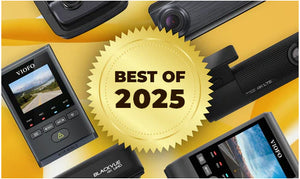One of the common questions we get asked from time to time is, how well can a dash cam pick up details like license plate numbers? So recently, we put four flagship dash cams to the test to see how well each performs in different situations.

How Well Can Your Dash Cam Pick Up License Plates?
Factors Affecting Your Dash Cam's License Plate Readability
1. Speed
Your vehicle’s traveling speed and the other vehicle's speed play an important role in your dash cam’s license plate readability. Going back to the 1080p Full HD dash cam - yes, it records in Full HD, but only when it’s a still picture. Motion changes everything.
If your vehicle travels much faster or slower than the other vehicle, chances are your dash cam will not be able to pick up all the license plate numbers and details. Most dash cams on the market shoot at 30FPS, and a speed differential greater than 10 mph would likely result in blurry details. It’s not your dash cam’s fault, it’s just physics.
That being said, if there was some point where you were traveling at the same speed as the other vehicle, you might be able to get a good view of the license plate in your video footage.
2. License plate design
Have you ever noticed that the license plates in North America often use very thin font, compared to those in Europe. Video cameras do not pick up thin fonts as easily, often blending into the background, making it blurry and hard to read. This effect worsens at night time, when the vehicle’s headlights reflect off the plates in front of you. This might not be obvious to the naked eye, but it makes reading license plates very difficult for dash cams. Unfortunately, there is no CPL filter that can remove this type of glare.
Image Source: Autopunditz.com
3. Recording Resolution
Resolution refers to the number of pixels in a frame. A higher pixel count gets you an image with better quality. For instance, 1080p means there are 1920 pixels wide and 1080 pixels high. Multiply together and you get 2,073,600 total pixels. There are 3840 times 2160 pixels in 4K UHD, so you do the math. If you are taking a picture of a license plate, you get more data or information from a higher resolution image as the extra pixels allow you to zoom in closer for farther away license plates.
4. Recording Frame Rate
Frame rate refers to the number of frames taken per second of whatever the camera is capturing. The higher the frame rate is, the more frame there are of that moment, thus allowing the footage to be more clear with fast-moving objects.
Learn more about recording resolution and frame rates on our blog, 4K or 60FPS - Which is More Important?
5. Image Stabilization
Image Stabilization prevents shakiness in your footage, allowing the most clear captured footage in bumpy situations.
6. Night Vision Technology
Night vision is a term used to describe the dash cam’s recording capabilities under low light conditions. Dash cams with the proper night vision technology typically adjust exposure automatically with changing light environments so that more details can be captured.
7. CPL Filters
In sunny and bright driving conditions, lens flares and over-exposed footage from the dash cam can compromise the ability to capture a license plate. Using a CPL filter can reduce these risks.
8. Recording Bitrate
High bitrate may improve the quality and smoothness of the video, especially when recording fast motion or high contrast scenes. But keep in mind that higher bitrate videos take up more space on the microSD card.
It’s still important to have a dash cam, because in the event of an accident, you know what cars are involved, the direction and traveling speed, and other important information. And once you’ve stopped, the camera can capture the license plates in 1080p Full HD.
Or another trick we like to use is reading the license plate you see out loud so that your dash cam can record the audio of you saying it. And that's it for now, folks. Hopefully, this covers everything you need to know about your dash cam's license plate readability. If there are any questions, feel free to reach out, and we'll get back to you as soon as possible!

